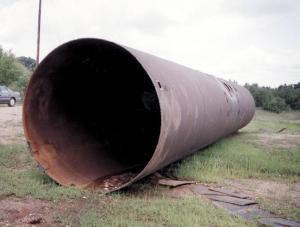2001 - Volume #25, Issue #5, Page #09
[ Sample Stories From This Issue | List of All Stories In This Issue | Print this story
| Read this issue]
Old Railroad Tank Cars Make Great Culverts
 |
 |
Terry Smith, Diversified Rail Car, Camden, Arkansas, has sold rail car culverts for several years, mostly in the Texas-Arkansas-Louisiana-Mississippi area.
"An old tank car with the ends cut off makes an ideal culvert. They're made of high quality steel at least half an inch thick. Some have 7/8-in. thick walls. They're stronger than corrugated culverts of comparable size, so they don't have to be handled so carefully," he adds.
Smith says tank car culverts are available in 7 to 10-ft. diameters and in lengths from 30 to 63 ft.
The ends are removed along with any plumbing or valves attached to the tank. Cutting off the dome on top leaves about a 2-ft. hole that usually must be covered or welded shut by the buyer. "If you can put the culvert into place with the dome hole down, it doesn't need to be covered," Smith notes.
"My main customers are county road maintenance departments, farmers and timber companies. I've seen counties use one, or even two or three to replace old bridges. Those old bridges must be inspected periodically and are in constant need of repair to keep them safe. Farmers use the tanks to make crossings in creeks and field ditches and to cross irrigation canals. Some actually put them together end to end and bury them to make underground irrigation canals or reservoirs. Some farmers have made runs as long as about 200 ft. with them. If they're going to do that, we leave one end on the tank that will be the end of the canal.
"Timber companies like them because they can use them to get logging trucks and big machinery into areas where they're cutting. And if they don't want to leave them in place once a stand of timber has been harvested and replanted, they can dig them out and move them to other areas to reuse," he says.
He says tank car culverts are priced comparably to corrugated culverts, but will last considerably longer because of the quality and volume of steel used in them. He says because the sides are smooth, a tank car culvert will allow as much as 25 percent more water flow than a comparably sized corrugated culvert.
"They don't need reinforcement when you're handling them, or support while they're being installed, as corrugated culverts do. In fact, they can be pushed into place with a dozer. If they get clogged, you can clean them out with a backhoe. That would ordinarily damage a corrugated culvert."
Smith sells tank car culverts for $75 to $100 per ft. depending on the diameter and thickness of the tank. He says delivery is extra and can add $400 or more, depending on how far the culvert must be hauled. "I can usually get them hauled for $1.50 a loaded mile, but sometimes it costs more," he says. He can usually arrange delivery within two weeks. "When someone calls me for a price, I give them a total for the culvert and delivery, so they know what their final cost is going to be."
Smith also sells retired flatcars for use as bridges.
Contact: FARM SHOW Followup, Terry Smith, Diversified Rail Car, P.O. Box 815 Camden, Ark. 71711 (fax: 870 836-9193).

Click here to download page story appeared in.

Click here to read entire issue
To read the rest of this story, download this issue below or click here to register with your account number.




